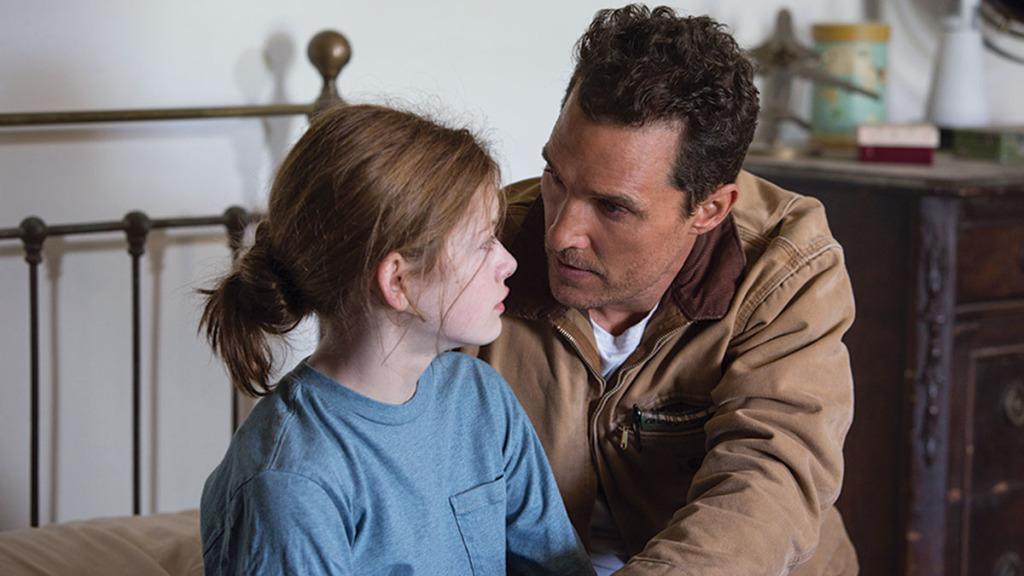Giant storms of dust are constantly ravaging the countryside, while humanity is slowly starving and suffocating — Earth is slowly becoming uninhabitable. Thus begins the central conflict of “Interstellar”: humanity’s survival.
“Interstellar” follows Cooper (Matthew McConaughey), a farmer that used to be a pilot and engineer for NASA. His young daughter, Murphy (Mackenzie Foy), has a “ghost” in her room that uses Morse code to communicate. During a dust storm, Cooper and Murphy witness the dust fall in a strange manner — one that relays the coordinates to a NASA base. There, Cooper is convinced to attempt to save humanity by going into space to scout three planets that are promising for humanity to survive on.
The intricate plot of “Interstellar” is another prime example of Christopher Nolan’s ambitious storytelling. Written by Nolan and his brother Jonathan, “Interstellar” includes science fiction, physics, time travel and a touch of family drama. The story takes on the difficult task of making intergalactic space travel understandable, with most of the dialogue proving useful for explaining the space travel in a comprehensible manner. For instance, during the exposition, Professor Brand (Michael Caine) provides dialogue that explains what tasks and difficulties the characters will be facing. In this respect, Nolan succeeds, allowing the audience to go on a long, tumultuous ride that pays off in a breathtaking final act.
“Interstellar” is arguably Nolan’s most ambitious project yet. The mastery and prowess that is required to pull off the many technical and storytelling feats is astounding. Any scene that shows space and unexplored planets proves that Nolan is at the height of his technical genius, with the different space visuals seeming well crafted, especially the different planets that allow Nolan to create whole new worlds that are realistic and expansive.
Another interesting aesthetic addition is the ship: While the characters were on their way to a wormhole that holds three promising planets, their ship is constantly spinning. The spinning makes the light in the spacecraft ever-changing, never allowing the characters to feel like they are in continuous movement. Tiny details like that constant motion add to the uneasiness and tension that slowly build throughout the movie.
The scenes shot on Earth are detailed, the images resembling Dust Bowl-esque filthiness. Dust coats everything, and there is an omnipresent, debilitating cough that occurs in much of Earth’s population. There is a stark contrast between the clinical precision of space and the grime that covers the Earth. The only green that is shown on the planet is the dying corn crops. The rest is swallowed up by the gigantic dust storms that ravage the country. In space, the colors are cool and pristine, providing a visual spectacle for the viewer. For instance, when the camera peeks outside in space, there is a beautiful moment when the ship passes Saturn that highlights the majestic intensity of space and its planets.
For the two-hour-and-49-minute-long run time, the movie keeps the intrigue and tension consistent. In a magnificent scene, Cooper is crying as he drives away from his family. There is a countdown while he is shown driving, and the next shot is swallowed by the all-encompassing flames of the spaceship as it leaves for outer space. This scene combines the technical aspects that “Interstellar” does so well with the heart-wrenching acting of McConaughey.
Hans Zimmer, a longtime collaborator of Nolan, outdoes himself once again. In “The Dark Knight,” Zimmer highlighted the impressive climaxes and emotional moments that occurred. Yet in “Interstellar,” while the swell of the score heightens every scene, there also are moments of utter silence that utilize the loneliness of space. Perhaps the most impressive musical moment comes in the breathtaking final act, where the score pushes the boundaries of tension.
Unfortunately, with the astrophysics-heavy plot, much of the character development is lost. Amelia Brand (Anne Hathaway), for instance, feels more like a plot device than a full-fledged character. Brand hopes to reunite with her lover who most likely perished on the previous space mission. However, it is hard to care for her relationship, as it only has a couple lines of dialogue devoted to it.
However, “Interstellar” succeeds in the sentimental, father-daughter relationship between Cooper and Murphy. It is in videos sent to Cooper that the movie hits its emotional peak: Murphy seems to be letting go of her father, even when Cooper needs her more than ever. Yet the one engaging relationship does not make up for the subpar treatment the rest of the characters receive.
The combination of brilliant acting by McConaughey; the sweeping, swelling score done by Zimmer; and the indelible technicality that Nolan uses add to the heightened effect of the movie. Sometimes the characters fall to the wayside because of the talk of physics, relativity and dimensions, but Nolan succeeds in reaching for the stars in “Interstellar.”




















